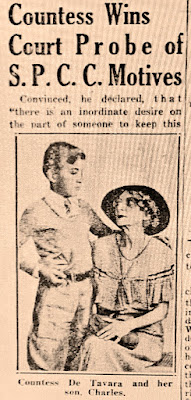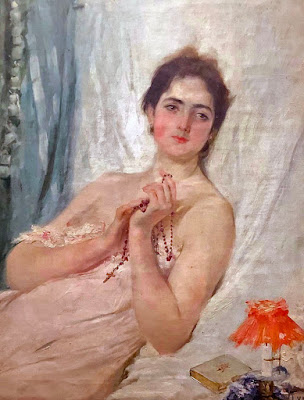Mistletoe, Art & the De Tavaras: Juicy Stuff of Scandal and Mystery
A fetching portrait of a pretty dancer led me on an epic Internet investigation of a pair of mysterious nobles- and then Art interfered and offered an intriguing solution.
There are people- you do not know any of them, people who prance across the backs of society from the day they are born- and do what they want, mostly undetected, and then dissolve into the mists of history. They do not answer to our rules or live within our paradigms. They are untouchable. They speak many languages, as they condescend to the rest of humanity. The ancient Druids were such persons, a ruling elite on the British Isles, whose symbol was the mistletoe.
Its berries white, shining like pearls, its roots penetrating into the flesh of its helpless host, mistletoe is perfectly camouflaged and out of reach, and in fact hardly ever noticed...
Mistletoe is a parasite which travels from canopy to canopy, sucking the life out of its hosts. It lives in the highest reaches of the forest, but it is not the forest. It does not care about rain or sun or geographical boundaries, and is not bothered by storms that come and destroy. It can always find a new living host, which will feed and hide it, until it too is exhausted. And there are people who operate much the same, still remnants of the ancient mistletoe people, even today.

In their youth they are the person who never has to study but makes A's. All while they tease and even torment the teachers. They are not learning what the rest of us are. We are worried about getting an education so we can be productive citizens in the forest of man. They are learning how to avoid that, and yet prevail. They are learning, while using charm and deception, about what they can get away with. And here is a slice of one of these mistletoe dynasties... found completely by accident... which is the only way anyone ever will...
I can hear them laughing, all the way across the past century since they first pulled off their ruse. Two Spanish immigrants- maybe they were Spanish, maybe they were immigrants, analyzing the American scene and lying their way to the highest strata of American society. Purportedly, he was a “count,” she a “countess.” He was a foreign diplomat, she a Daughter of the American Revolution. Or maybe they were. Whoever, whatever they were, they knew just how to present themselves, how to earn confidence, and how to achieve their goals.
Their last name was De Tavara. If you were nobility from Europe, you had to have a distinguishing “De” before your surname. De just means of. It usually came in front a place name. You were John Pardo of Toledo, not to be confused with John Pardo of Madrid. And there were De Tavaras and De Taveras spreading all over the globe at the time, from the Philippines to Peru to the United States. A study of this name will become significant as you read on.
The Tavara are a tribe in Rhodesia, but we will skim over that and call it a linguistic coincidence. The word tavara is found today stretching from Hindi to Finnish, but seems to have come from ancient sources, traced through Russian back to Proto-Slavic, and Turkic origins. It meant merchandise... goods... so a person named Tavara might well have been a merchant along the Silk Road. The name had Jewish context in India, but today it is most prominent in Mexico, probably via Spanish immigrants. In the Finnish language, used in the plural, it can also connote stuff... and is used figuratively to mean meat. And it is used colloquially to suggest the female genitalia. Hold that thought... especially the idea of de (of) tavara (vagina); a crude way to suggest an illegitimate child with a mother and no father.
But anciently, tavara signified the cream of civilization. Punjabi denotes tavara as their word for tower. In ancient times, it was towers which were built to please the Aryan Brahmans (ancestors of the Druids) and town builders of India, to symbolize Indian civilization and commerce and their authority over it. To the nearby Kannadans, it means tin or zinc or its alloys. These were precious and essential metals sought during the bronze age to make bronze, the first metal manufactured to make durable weapons and utensils. There is a town called Tavara in Bengaluru, Karnataka (south central India), which is known as a mining center. Anyone in ancient times or even today who had tavara was rich and powerful.
Originally persons branded with this ancient name and all of its associations sound very much like the profile of an ancient Kushan family, a nomadic tribe most notorious as traders of silk, slaves, horses and precious metals along the Silk Road, which transected central Asia. The Kushans have been linked to the Yue Chi of China, the Turks, and certainly the ancient ruling Aryan class of India. When the native Indians finally threw off their yoke, the Kushans and their tavaras disappeared into history. I might add, not much good has developed there since. Over the next thousand years, the Tavaras probably forgot what their name originally meant... other than their new identity as merchants- traders and opportunists.
More recently, “Tavara” was actually a place, and known in Spain as a prime olive oil producing region, and thus a springboard for prosperous Spanish nobles who owned the land there. But that did not matter, because King Carlos I had established the title of Marquis de Tavara in 1541. God only knows how many descendants had come down since then, associated with that title. So this Spanish couple, the De Tavaras might well have been some of these offspring. Maybe they were. But in the U.S., it was easy enough to claim such nobility. Most importantly, it was impossible to verify.
Either way, this couple understood to some degree the advantages of claiming the name De Tavara. To Europeans it simply meant “old money.” But as this mistletoe couple crossed the Atlantic, the name meant nothing in the beginning, as it took awhile for the De Tavaras to find suitable hosts. But to these young parasites, making a name was not near as important as running the game.


























No comments:
Post a Comment
Thank you for sticking your finger into the fire...please drop your thoughts into it!